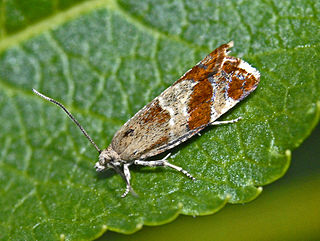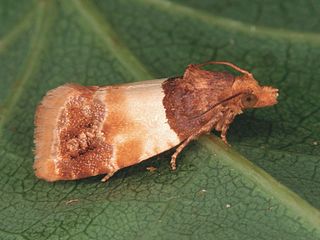
Epinotia tedella is a moth of the family Tortricidae. It is found in Europe.

Epinotia ramella is a moth of the family Tortricidae. It is found in Europe, China, Japan, Russia and Kazakhstan.

Epinotia immundana is a moth of the family Tortricidae. It is found in China (Qinghai), Russia and Europe.

Epinotia solandriana is a moth of the family Tortricidae. It is found in Europe, China, Korea, Japan, and Russia.

Epinotia is a very large genus of tortrix moths. It belongs to the tribe Eucosmini of subfamily Olethreutinae.

Philedone is a genus of moths belonging to the subfamily Tortricinae of the family Tortricidae. It contains only one species, Philedone gerningana, the cinquefoil tortrix or cinquefoil twist, which is found in Asia and Europe. It was first described by the Austrian lepidopterists Michael Denis and Ignaz Schiffermüller in 1775.

Epinotia cruciana, the willow tortrix, is a moth of the family Tortricidae.

Epinotia nanana, the European spruce needleminer, is a moth of the family Tortricidae. It is found from northern and central Europe to Russia and Mongolia.
Epinotia rubiginosana is a moth of the family Tortricidae. It is found from Europe to eastern Russia, China, Korea and Japan.

Epinotia tenerana, the nut bud moth or alder tortricid, is a moth of the family Tortricidae.

Epinotia brunnichana is a moth of the family Tortricidae. It is found in most western, central and northern Europe, the Near East and further east to the eastern Palearctic realm, where it has been recorded from Russia, Kazakhstan, China, and Japan.

Epinotia demarniana is a moth of the family Tortricidae found in most of Europe, east to the eastern part of the Palearctic realm.

Epinotia nisella is a moth of the family Tortricidae which is found in the Palearctic, Europe and North America. It was first described by Carl Alexander Clerck in 1759.

Epinotia tetraquetrana, the square-barred bell, is a moth of the family Tortricidae. It is found from most of Europe east to the Near East and the eastern part of the Palearctic realm.

Epinotia festivana is a species of moth of the family Tortricidae. It is found in most of southern Europe and the Near East.

Epinotia trigonella, the birch epinotia moth, is a species of moth of the family Tortricidae. It is found in most of Europe, east to the eastern Palearctic realm. It is also found in North America.

Gynnidomorpha alismana, the water plantain conch, is a moth of the family Tortricidae. It was described by Ragonot in 1883. It is found in most of Europe, except Spain, Switzerland, most of the Balkan Peninsula and Ukraine. Further east it is found across the Palearctic to China and Korea. It is found in riverine and other watery habitats.

Epinotia nemorivaga, the bearberry bell, is a species of moth in the family Tortricidae. It is found in Europe and Asia.

Epinotia subocellana is a species of moth of the family Tortricidae. It is found in Asia and Europe and was first described by Edward Donovan in 1806.

Epinotia abbreviana is a moth of the family Tortricidae. It is found in Europe and was first described by Johan Christian Fabricius in 1794.



















